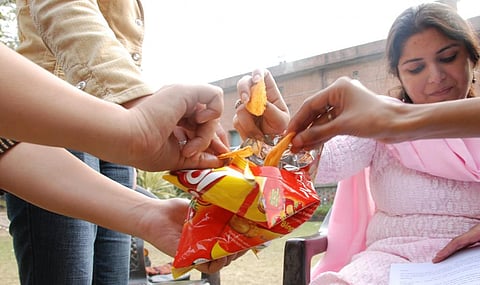

Given so much delay and the public health challenge due to bad food, one would have hopes FSSAI to lear from the global best practice. Countries are learning that too many labels do not work. Instead, warning labels are the best option. Another concern is that with so many numbers on the front, the red mark on FoP for one component could mislead consumers. This is because other components may not be over the threshold. If this is coloured green, it would make us take decisions based on how many green boxes verses how many red boxes. This would mislead and misinform.
In the 2019 draft, FSSAI has kept open the option to add colours in the FoP labelling. So a colour like green, that gives a positive signal, may be added to the label in future. Such traffic light labelling sends a mixed message to the consumer and is known not to help the consumer.
This is why countries are choosing to introduce warning labels, which are marked prominently for each nutrient. This is the global best practice. Chile’s warning label is a black and white octagonal sign to flag packaged foods with excess calories or nutrients. The label is easy to understand. It does not contain numbers and needs no calculations. All that it says is: “High in Sugar” or “High in Calories”. If a product is high in two ingredients, it will be highlighted through two octagons. At one glance, it warns the consumer how healthy or unhealthy a product is.
Warning labels were first implemented in Chile in 2016. Guillermo Paraje, an associate professor at Adolfo Ibáñez University, Chile says, “Warning labels can be understood even by six-year-old children—they are simple, clear and convey the information you need.” It has been effective and proven to simplify nutrition information.
A year after its implementation in Chile, “the per capita consumption of carbonated beverages reduced by 24.9 per cent in the first evaluation. Mothers, who did not understand labels earlier, now use the number of labels as a guide and understand that products with more labels are less healthy,” says Barry Popkin, a professor of nutrition at the UNC Gillings School of Global Public Health, US. Warning labels have been implemented in Peru and Canada. Uruguay, Singapore, Mexico and Israel are at different stages of implementing them.
In Chile, warnings are big in size and occupy a substantial part of FoP. They are placed on the upper-right side of the pack with a white contrast border to the black labels. This enables clear identification.
Such a label can succeed in India because a big section of the population here is illiterate or cannot read English, the most used language. FoP labels for vegetarian or non-vegetarian food have been quite successful. FSSAI itself, through the existing regulations, specified the green and red dots so that the information was easy to comprehend. But the food regulator refuses to learn from its own experience.
How much is one serveIn India, the serving size is not standardised. In absence of sound regulations, some companies declare it on their food packages, while some don't. There are a few who declare it on their websites. The draft Food Safety and Standard (Labelling and Display) Regulations, 2019, proposes the serving size and the number of serves to be mentioned. It also mandates per serve contribution to Recommended Dietary Allowance. But what does serving size really mean?A serving size refers to the quantity of food typically consumed in one go. It varies for different food categories. For instance, it’s 30 g for chips, 35 g for namkeen and 60 g for instant noodles. The problem is that more often than not, the size of packets does not match the serving size. For instance, a 52-g or 60-g pack of chips can declare 30 g as the serving size. This leads to excess consumption. In case of fast foods, one ends up eating an entire burger. The serving size could be kept simple. A handful, a spoonful or a cupful is much easier to understand. But that's unlikely to happen. All efforts in this case lead to one result—keep the consumer addicted to junk food and make sure they do not have enough information to make an informed choice. |